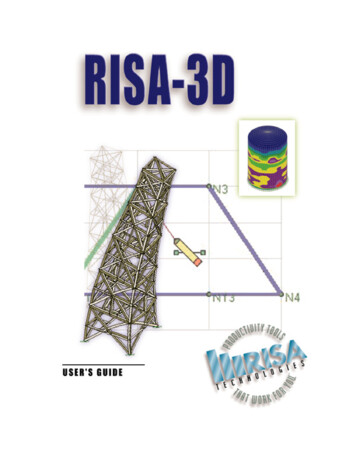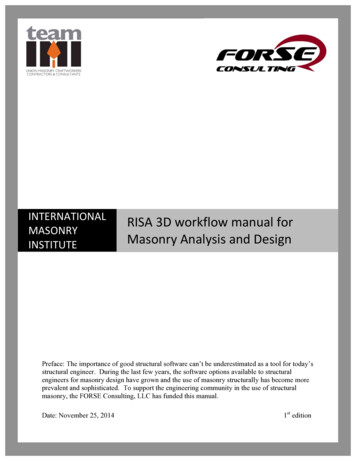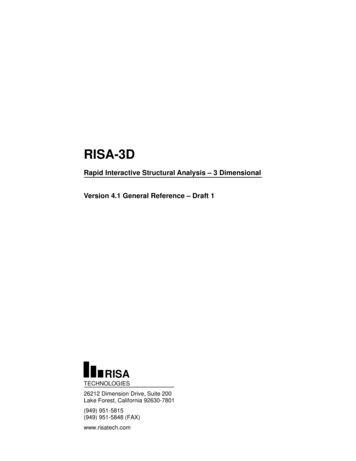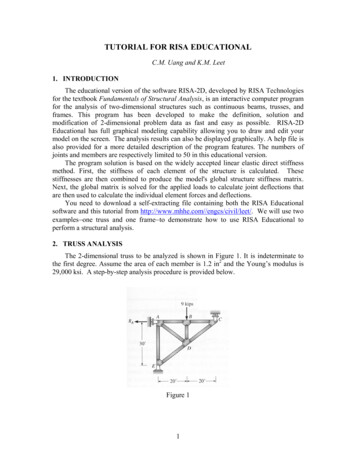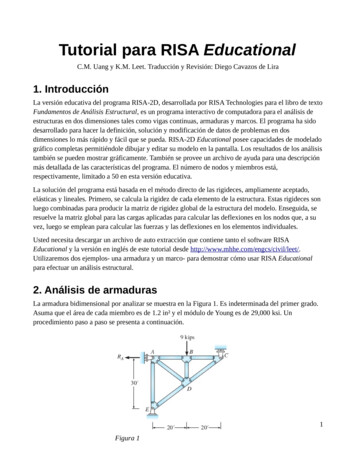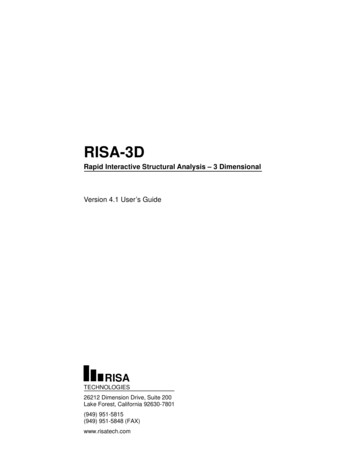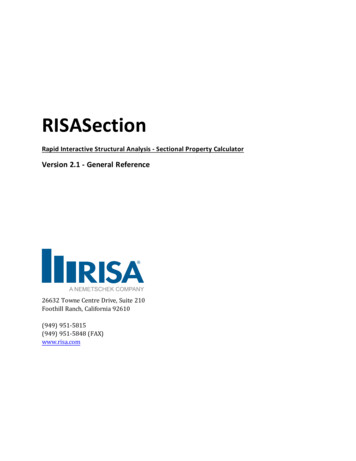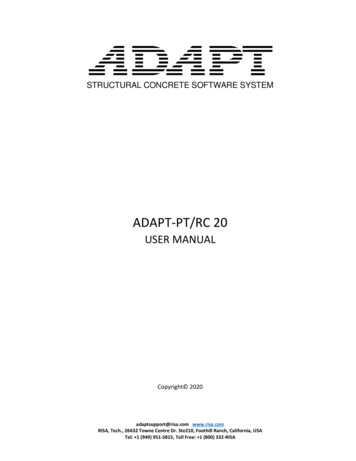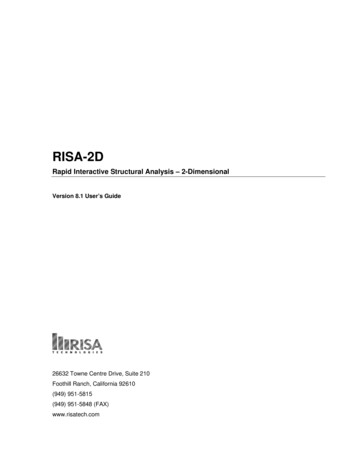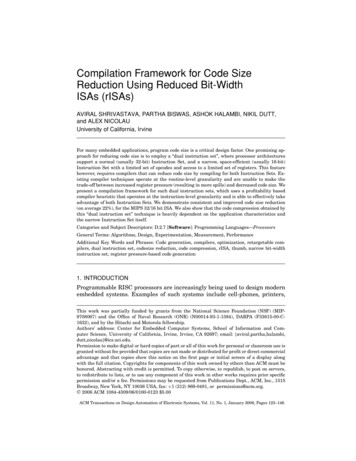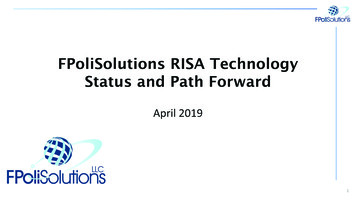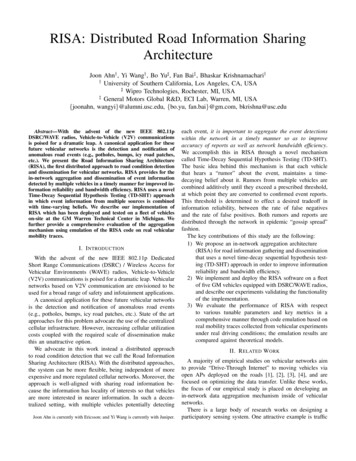
Transcription
RISA: Distributed Road Information SharingArchitectureJoon Ahn† , Yi Wang† , Bo Yu] , Fan Bai‡ , Bhaskar Krishnamachari†† University of Southern California, Los Angeles, CA, USA] Wipro Technologies, Rochester, MI, USA‡ General Motors Global R&D, ECI Lab, Warren, MI, USA{joonahn, wangyi}@alumni.usc.edu, {bo.yu, fan.bai}@gm.com, bkrishna@usc.eduAbstract—With the advent of the new IEEE 802.11pDSRC/WAVE radios, Vehicle-to-Vehicle (V2V) communicationsis poised for a dramatic leap. A canonical application for thesefuture vehicular networks is the detection and notification ofanomalous road events (e.g., potholes, bumps, icy road patches,etc.). We present the Road Information Sharing Architecture(RISA), the first distributed approach to road condition detectionand dissemination for vehicular networks. RISA provides for thein-network aggregation and dissemination of event informationdetected by multiple vehicles in a timely manner for improved information reliability and bandwidth efficiency. RISA uses a novelTime-Decay Sequential Hypothesis Testing (TD-SHT) approachin which event information from multiple sources is combinedwith time-varying beliefs. We describe our implementation ofRISA which has been deployed and tested on a fleet of vehicleson-site at the GM Warren Technical Center in Michigan. Wefurther provide a comprehensive evaluation of the aggregationmechanism using emulation of the RISA code on real vehicularmobility traces.I. I NTRODUCTIONWith the advent of the new IEEE 802.11p DedicatedShort Range Communications (DSRC) / Wireless Access forVehicular Environments (WAVE) radios, Vehicle-to-Vehicle(V2V) communications is poised for a dramatic leap. Vehicularnetworks based on V2V communication are envisioned to beused for a broad range of safety and infotainment applications.A canonical application for these future vehicular networksis the detection and notification of anomalous road events(e.g., potholes, bumps, icy road patches, etc.). State of the artapproaches for this problem advocate the use of the centralizedcellular infrastructure. However, increasing cellular utilizationcosts coupled with the required scale of dissemination makethis an unattractive option.We advocate in this work instead a distributed approachto road condition detection that we call the Road InformationSharing Architecture (RISA). With the distributed approaches,the system can be more flexible, being independent of moreexpensive and more regulated cellular networks. Moreover, theapproach is well-aligned with sharing road information because the information has locality of interests so that vehiclesare more interested in nearer information. In such a decentralized setting, with multiple vehicles potentially detectingJoon Ahn is currently with Ericsson; and Yi Wang is currently with Juniper.each event, it is important to aggregate the event detectionswithin the network in a timely manner so as to improveaccuracy of reports as well as network bandwidth efficiency.We accomplish this in RISA through a novel mechanismcalled Time-Decay Sequential Hypothesis Testing (TD-SHT).The basic idea behind this mechanism is that each vehiclethat hears a “rumor” about the event, maintains a timedecaying belief about it. Rumors from multiple vehicles arecombined additively until they exceed a prescribed threshold,at which point they are converted to confirmed event reports.This threshold is determined to effect a desired tradeoff ininformation reliability, between the rate of false negativesand the rate of false positives. Both rumors and reports aredistributed through the network in epidemic “gossip spread”fashion.The key contributions of this study are the following:1) We propose an in-network aggregation architecture(RISA) for road information gathering and disseminationthat uses a novel time-decay sequential hypothesis testing (TD-SHT) approach in order to improve informationreliability and bandwidth efficiency.2) We implement and deploy the RISA software on a fleetof five GM vehicles equipped with DSRC/WAVE radios,and describe our experiments validating the functionalityof the implementation.3) We evaluate the performance of RISA with respectto various tunable parameters and key metrics in acomprehensive manner through code emulation based onreal mobility traces collected from vehicular experimentsunder real driving conditions; the emulation results arecompared against theoretical models.II. R ELATED W ORKA majority of empirical studies on vehicular networks aimto provide “Drive-Through Internet” to moving vehicles viaopen APs deployed on the roads [1], [2], [3], [4], and arefocused on optimizing the data transfer. Unlike these works,the focus of our empirical study is placed on developing anin-network data aggregation mechanism inside of vehicularnetworks.There is a large body of research works on designing aparticipatory sensing system. One attractive example is traffic
monitoring application that uses a number of active probevehicles to estimate traffic flow. The technical feasibility ofthis participatory sensing system was initially evaluated usingembedded vehicle telematics systems ([5],[6]); realizing thatthe rapid growth of cellular phones could create alternativeways of implementing traffic probe system, the authors of[7], [8], and [9] proposed to use mobile phones (instead ofembedded telematics systems) to detect traffic flow and predicttravel time on a one-dimensional highway, while the authorsof [10] suggested to do so for traffic estimation on twodimensional surface streets. Unlike the cellular-centric datacollection approach, the Cartel project [11] tries to leveragescattered deployments of hot-spots as a new “data pipe” foruploading traffic probe data. In all the above approaches,traffic probe data collected from the physical world is movedvia ubiquitous wireless infrastructure to a cyber-space centralserver for further data processing (traffic flow estimation, traffic pattern identification, traffic anomaly detection), before theknowledge extracted from data is presented to end users [12].In contrast, our work advocates a distributed in-networkinformation processing protocol (including data aggregation,storage and replication) within the vehicular network, for suchtraffic/road monitoring applications.Another line of work related to ours is how to furtherimprove sensing capability in order to detect different physicalphenomenon on the road accurately. The authors of [13]showed that a hybrid localization scheme using cellular andWiFi signal (in addition to GPS) could tolerate significantsignal noise and/or GPS outages, achieving accurate traveltime estimation. The authors of [14] and [15] used a richset of inexpensive cellphone-equipped sensors (including accelerometers, microphone, GSM radios and GPS sensors) todetect potholes, bumps, braking and honking in less regulatedtraffic which is important to developing countries. The authors of [16] focused on detecting road pothole events usingvibration and GPS sensors. Similarly, using GPS sensor andultrasonic radar, the authors of [17] showed that a vehicularparticipatory system could discover empty road-side parkingslots. (Needless to say, the accurate detection of an emptyparking slot and its location is the cornerstone of such system.)Finally, via accessing fuel usage information of vehicle OBDII systems, the authors of [18] demonstrated a participatorysensing system that improves fuel efficiency. The focus ofour work being on network-level data aggregation of detectedphysical events among participants, our system could leveragethese works that tackle the challenge of providing accuratedetection results using a variety of on-board sensors.Our work represents the first distributed, in-network dataaggregation system for vehicular networks which enablesparticipating cars to collaborate on developing a consensusabout detected physical events on the road. Such an innetwork system does not necessarily require the engagementof ubiquitous wireless infrastructure, thus reducing the relianceof often congested cellular networks in the major metropolitanarea.Fig. 1.RISA mechanismIII. RISA A RCHITECTUREIn this section we describe our road information sharingarchitecture (RISA).A. OverviewThe key idea of RISA is to aggregate the event information announced by multiple sources within the delay tolerantnetwork (DTN) to enhance both accuracy of the information and bandwidth efficiency of a vehicular ad-hoc network(VANET). The aggregation mechanism in RISA is inspired bythe classical sequential hypothesis testing (SHT) technique foridentifying events based on stochastic observations obtainedsequentially over time [19].In RISA, as each car encounters other cars that provide themwith new event detection samples, it sequentially increases itsbelief about the road event until the detection becomes credibleenough to become a confirmed observation of road events(similar to the traditional SHT). However, unlike SHT, thephenomenon to be detected in our setting is time-varying (e.g.,a pothole may become filled, or an icy-patch may disappeardue to warming), which discounts the credibility of oldersamples. In order to deal with this property, we allow for beliefvalue of events to be decreasing over time; and sequentiallyadd the time-decayed beliefs corresponding to encountereddetection samples until they cross a predefined threshold.This time-decay SHT (TD-SHT) mechanism allows for eventconfirmations that are both reliable and time-sensitive.RISA-capable vehicles monitor their environment for theinterested road events. When a vehicle detects a road event, itcreates and stores an EventRumor which contains the information about the detection sample for the event. It also broadcaststhe rumor to its direct neighbor vehicles. When a vehiclemeets another RISA vehicle, they transfer their knowledgeof road events to each other, and the knowledge includesEventRumors. When a vehicle gathers enough rumors of acertain road event, it produces an EventReport as a conclusionon the event by merging the rumors. The EventReport ispropagated to a much larger set of vehicles, giving notificationto drivers/passengers in the vehicles. While an individualEventRumor is treated as inconclusive, an EventReport isconsidered trustworthy information to report to people.The high-level distributed algorithm for each vehicle ofRISA is depicted in Figure 1. The details of each algorithmintroduced in the figure are presented in the next subsections.The definitions of symbols used in the algorithms are presentedin Table I.
Symbolsbv(s, t)bvminbvtotthcssf ind event report(r)Descriptionthe belief value of s at time tthe minimum belief valuethe total belief valuethe consensus thresholdthe function that returns the eventreport corresponding to rumor r(a) Road event timelineTABLE ID EFINITIONS OF SYMBOLS USED IN ALGORITHMS(b) Total belief value time evolutionB. Road EventIn the RISA architecture, we are interested in discrete roadevents such as traffic congestion, potholes, ice patches, trafficlight malfunction, obstacles on the road, etc. Road events areclassified in our RISA system by the tuple: type, location,location precision . They are first classified based on theirtypes – such as pothole or congestion – and the location points.The data structure of RISA does not explicitly distinguish twotemporally disconnected road events on the same location, aslong as they are of same type. However, since the focus ofRISA is on providing time-sensitive event reports, informationabout sufficiently old events does not persist in the systemdue to the time-decaying beliefs adopted in our TD-SHTmechanism.C. Core Mechanism1) Aggregation Algorithm: We first introduce metrics toevaluate the credibility of information – belief value and totalbelief value.The belief value is the amount of credibility of the roadevent information in its associated EventRumor or EventReportat the given time. When a new EventRumor is created by avehicle that detects a road event, a predetermined initial beliefvalue b0 is assigned to the rumor. As time goes, the beliefvalue of the rumor is changed following a predetermined decayfunction in order to discount the aged information. Althoughthe decay function may be any non-increasing function of theelapsed time from the creation of the rumor, we focus on theexponentially decreasing function in Section VII.The total belief value is the aggregated belief value of aset S of EventRumors at the given time. The total belief valuerepresents how much one can believe that the associated eventis true at the given time after obtaining information frommultiple sources. We use the sum of individual belief valuesbv(si ) of EventRumors si for aggregation in this paper asgiven by Equation (1). But, our architecture can support anarbitrary function mapping a set of belief values into a scalar.Pbvtot (S, t) i bv(si , t)(1)Now let us look at the aggregation algorithm M AKE C ON SENSUS which is the core algorithm of RISA architecture.The algorithm is the consensus mechanism for combininginconclusive event detections represented by EventRumorsfrom different nodes at different times into one trustworthyconclusion – EventReport. As can be seen in Algorithm 1,its basic operation is to evaluate the total belief value of thegiven road event and compare it with the predefined consensusthreshold. If the total belief value of rumors is larger than the(c) Timeline overlap of road event and RISA perceptionFig. 2.Belief value interpretationthreshold, it proclaims a conclusion on the considered roadevent and creates an EventReport for the event. Otherwise,the RISA system adds the rumor into its corresponding set anduses it in the future. The consensus conclusion is honored untilits belief value falls below the minimum belief value. Afterthat, the system abandons the report and regards the event ashaving disappeared. If a RISA car receives an EventReportfrom another RISA car when it has not reached a consensus,it acknowledges the road event as truthful and discards all theassociated rumors in its storage. In this way, the distributedalgorithm of RISA can converge quickly.Figure 2 illustrates this aggregation mechanism in the timerange of [300, 600] seconds. The data in the figure is fromone of our experiments in Section VII. Figure 2.(a) shows thetimeline of the road event, where value 1 means the occurrenceof the event. Figure 2.(b) shows the time evolution of the beliefvalues of the road event in a given car, and its perception ofthe event. This subfigure shows that the total belief value stepsup with the detections or receptions of rumors while it decaysotherwise. At t 579.2, the value exceeds the consensusthreshold (i.e. 25 in this case) leading to a consensus; the caracknowledges the road event from this moment.Figure 2.(c) overlaps the timeline of the real occurrence ofthe road event and the perception of the car. We can see twolags – aggregation delay and persistence error. The aggregationdelay is between the start time of the road event and theperception, and the persistence error is between the end ofthe road event and that of perception.2) Phased Operation: The RISA mechanism can be dividedinto two phases for each road event, and the transition istriggered by the creation of an EventReport.In Phase 1, when a RISA-capable vehicle detects a roadevent, it creates an EventRumor for the event and executesM AKE C ONSENSUS with the rumor and the set of previousrumors for the event in its storage, if the set exists. Ifthe aggregation algorithm successfully makes consensus andproduces an EventReport, RISA goes into Phase 2.If the vehicle receives EventRumors from another vehicle,it executes M AKE C ONSENSUS with them one-by-one. If itreceives the EventReport of the road event, it keeps the reportand refreshes its belief value with the largest belief value of itsown rumors of the event if the latter is larger than the given
Algorithm 1 M AKE C ONSENSUS(rmr, S)S : the set of EventRumors of same road event as rmr in thestorageif S has already included rmr thenreturn NullConsensus;t : current time;for each element si of S doif bv(si , t) bvmin thenremove si from S;Add rmrPinto S;bvtot : i bv(si , t);if bvtot thcss thenrpt : event report(event inf o(rmr), bvtot , t, node id);Remove S from the system;return rpt;elsereturn NullConsensus;belief value of report. It does not add all individual beliefvalues of the rumors to the report’s value because it can makethe report’s belief value too high to make it stay too long inthe system, potentially giving stale information to participants.A pair of RISA vehicles exchange all rumors that exist inonly one of them upon their encounter, which indicates thatmultiple rumors of the same event spread over the networkwithout aggregation in this phase. However, the spread isexpected to be confined near the origin of road event becauseall rumors are abandoned once they produce an EventReportor they meet the EventReport of the same event.This phase may use more resources such as communicationbandwidth and storage due to the lack of aggregation, butthis is helpful to obtain more accurate aggregation at the end,avoiding double-counting of same rumors. In fact, we canimprove the efficiency of Phase 1 by adopting an additionalaggregation technique (e.g. FM-Sketch [20]) that is robust todouble-counting even in this level. But, we focus on its basicfunctionality in this paper.In Phase 2, the vehicle has only one EventReport for theroad event, and propagates it to other vehicles until it becomesexpired. When the vehicle receives another EventReport ofthe same event from another vehicle, it refreshes the beliefvalue of its own report by updating it with that of the receivedreport, if the latter is bigger than the former. It discards thereceived report after that as the way of aggregation. Theprocedure is similar when the vehicle receives an EventRumor– it refreshes the belief value of its own report and discardsthe rumor. These behaviors could be seen in Figure 2.(b) in[1000s, 1700s] interval. In this way of aggregation, the systemsaves the bandwidth and storage by keeping only one reportand no rumors for a road event. When the report belief valuefalls below the minimum belief value, the system discards thereport and regards the road event as being disappeared as inFigure 2.(b) at t 2097.18.These double-phased operations are controlled by O N RUMOR and O N R EPORT. Their pseudo codes are presentedin Algorithms 2 and 3.Algorithm 2 O N RUMOR(rmr)rmr : new EventRumor;rep : f ind event report(rmr);if rep is not empty thent : current time;bv(rep) : max(bv(rep, t), bv(rmr, t));returnelseS : local set of EventRumors equivalent to rmr;c : M akeConsensus(S, rmr);if c is a valid EventReport thensave c in the node;returnAlgorithm 3 O N R EPORT(rep)rep : new EventReport;t : current time;replocal : f ind event report(rep);if replocal is not empty thenbv(replocal ) : max(bv(replocal , t), bv(rep, t));returnelseS : local set of EventRumors equivalent to rmr;if S is not empty thenUpdate S with decay function;Remove si from S if bv(si , t) bvmin for all si in S;bv(rep) : max(maxi (bv(si , t)), bv(rep, t));Discard S;save rep in the storage;returnD. Tunable ParametersThe RISA architecture has several tunable parameters. Inthis section, we introduce them and describe their first-ordercontributions.Consensus Threshold (thcss ): This is the minimum totalbelief value such that its associated set of EventRumors isto be promoted to an EventReport by being recognized astrustworthy and conclusive information. This value contributesto timing of phase transition in RISA.Initial Belief Value (b0 ): This is the initial and maximumpossible value for an individual EventRumor. This value affects the lifetime of the EventRumor and the consensus timing.Minimum belief value (bm ): This value is the smallest valueof belief of an event rumor/report for them to survive and bepropagated over the network. If an event rumor/report has thebelief value decayed to less than this value, it is consideredexpired and will be discarded.Decay function (d(τ )): This function decides how the beliefvalue decays over time, affecting the consensus timing and thelifetime of event rumors and reports. The decay function canbe different between EventRumor and EventReport even forthe same type of road event.The initial and minimum belief values and decay function jointly decides the lifetime of EventRumors, given byEquation (2). The lifetime of EventReports with no refreshis decided with one more parameter which is the consensusthreshold, given by Equation (3). However, its overall lifetime
Fig. 3.RISA Software Systemalso depends on the refresh process, which is hard to derivebecause it depends on the random process of detections and thecommunication delay from the detector to the report holder.τrumorτreport arg minτ (max{b0 d(τ ) bm , 0})arg minτ (max{(thcss b0 )d(τ ) bm , 0})(2)(3)We note that the parameters are not independent, but thesame effects can be drawn by fixing some parameters andadjusting others properly. For example, the same lifetime canbe achieved for a rumor by doubling the initial belief value,when the minimum belief value is also doubled. The effectsof these parameters are further investigated with the results ofperformance evaluation in Section VII.IV. I MPLEMENTATIONWe developed a prototype system composed of hardwareand software in order to experiment and evaluate the RISAarchitecture. This prototype system was installed on a fleetof five GM testing vehicles for empirical experiments in realdriving environments.A. Software and Hardware SystemHardware System: Each of the GM research vehicles thatwe used for the experiment is equipped with a Linux laptoprunning our prototype RISA software, a DSRC-compatibleDenso WRM radio operating the IEEE 802.11p WAVE BSSmode on the 5.9 GHz frequency band, transmitting at 20 dBm,6 Mbps data rate, with an omnidirectional 0 dB gain antennamounted on the roof, and a GPS unit with 1m accuracy, usedfor location and time synchronization. Note that our testingvehicles are not equipped with real event detection sensors, aswe do not focus on the local event detection problem in thispaper. Instead we use virtually generated event detections.Software System: The software system is built on top ofa customized software system called WaveCast [21], whichis used to support vehicular opportunistic communicationresearch. It consists of the entire DSRC protocol stack (up tonetwork-layer), based on GrooveNet [22]. As a modularizedtest platform, WaveCast is flexible enough to support the development of a variety of vehicular communication applications,using standard network-layer APIs. The architecture of oursoftware system is depicted in Figure 3.Our software system also provides a set of Graphic UserInterfaces, which are able to display a map, vehicle dynamicinformation, neighboring vehicles, road events (such as RISAevents), as well as radio and GPS status information. Oursoftware system is composed of about 50,000 lines, of whichabout 12500 lines correspond to RISA module.Our developed software system is able to run in two modes:real experiment mode and emulation mode.Real Experiment mode: On top of WaveCast system, weimplemented the RISA mechanism introduced in the previoussection. Each testing vehicle is equipped with its own WaveCast system and RISA protocol (as a single node). Using 5such testing vehicles as a small-scale testbed, we are able torun experiments with the full functionalities of RISA protocolin the real driving environments.Emulation mode: We also modified our WaveCast softwaresystem to support the emulation mode that support multiplecars to run RISA protocol on a single machine, as other traditional simulators/emulators. In addition we added a vehiclemobility module into our software system that takes GPStraces as input and moves cars accordingly in the simulationmode. We use this feature for RISA emulation as discussedin Section VI. Note that the exact same RISA code is usedfor both real experiments and the emulation mode, so thatwe believe that our emulation results using empirical vehicletraces are trustworthy.V. R EAL E XPERIMENTWe first run a representative set of real experiments with ourprototype system on vehicles to demonstrate the correctnessof the architecture and its software implementation. Figure 4shows the results of two samples of the experiments. In theexperiments we had three cars, whose paths are shown ascolored curves, and one pothole road event (shown as a star).The first experiment Exp1 is the case in which the carsthat detect the road event make consensus, and let other carsknow. As shown in Figure 4.(a), Car 1 (red) detects the potholeat 03:40.522 and broadcasts the EventRumor. Car 2 (yellow)that follows Car 1 within the radio range receives the rumorat 03:41.501 and keeps it. Soon it also detects the pothole andcreates an EventReport for it because the total belief valueexceeds the consensus threshold. It broadcasts the report andCar 1 receives it at 04:16.261, which is transferred to Car 3(blue) at 04:30.863. Figure 4.(b) shows how the perception ofeach car for the pothole changes over time in Exp1. Althoughthe perception is either on (1) or off (0), we put the stateof 0.5 in the plot to identify the time duration that the carhas rumors only. In the figure we can see that Car 2 receivesthe rumor Car 1 created almost immediately because they arewithin the radio range at that time. But, Car 1 is out of rangewhen Car 2 creates the report so that we can see a time lagbetween the time Car 2 confirms the pothole and the time ofCar 1. Because Car 3 receives the report without any rumors,its perception goes from 0 to 1 directly.Figures 4.(c) and (d) pertain to the second experiment Exp2,which shows a case when the consensus is made in the car(Car 3) that does not detect the road event at all. This happenswhen the cars that detect the event (Car 1 and Car 2) keep outof the radio range of each other, but encounter the same othercar (Car 3) at later times.
(b) Exp1-Perception(a) Exp1-Map(d) Exp2-PerceptionFig. 4.(c) Exp2-MapReal Experiments with RISAVI. T RACE C OLLECTION E XPERIMENTS AND E VALUATIONM ETHODOLOGYHaving already validated the functionality of the RISAprotocol on real vehicles as described in section 5, we nowwish to comprehensively evaluate the RISA system over manydifferent parameter configurations. For this purpose, we didnot run the RISA protocol directly on the cars; instead, wehave emulated the RISA protocol offline based on the abovementioned mobility traces from vehicles driving through realroads. Because we are more interested in the early phaseof smart vehicle deployment, we focus on the low densityof RISA cars, which make them operate as a delay tolerantnetwork.We used a fleet of five GM research vehicles for the experiment to collect movement traces and interactions between carsin real traffic. We drove the fleet of cars circling on MoundRd, Warren, MI, USA from 12 Mile Rd to 14 Mile Rd, whichis one of the major streets in the region carrying a large trafficvolume.We chose to circle within the same street to include theinteraction between cars in opposite directions, with a smallnumber of research cars. We conducted the experiments inhigh traffic time (i.e. 7am-9am, Oct. 17th, 2010) and lowtraffic time (i.e. 1pm-3pm, Oct, 18th, 2010), making for 20driving hours in total (across all vehicles). The vehicles areinserted one-by-one into the real road traffic with an initialinter-vehicle time interval of 90 seconds. We did not controlmanually the distance between cars, but let each car followthe real traffic accordingly. So, the experiment experiencedthe inversion of the order of cars sometimes. During theexperiment, we collected the GPS traces of the vehicles; eachcar sampled the GPS location every second.In our evaluations described in Section VII, we assume thata pair of cars can communicate with each other if their distanceis less than a predefined radio range. We use 200 meters forthe radio range, which is more conservative than suggestedby [23], [24]. In the emulation we have injected virtual roadevents on the road. The position of the event is uniform atrandom over the experimented street, and the arrival time ofthe road events follows Poisson distribution with the mean of180 seconds, unless stated otherwise.VII. E VALUATIONWe evaluate empirically the RISA system in this section,by examining the effect of various RISA system parameterson two major performance metrics – aggregation delay andconsensus accuracy.A. Aggregation DelayIn this section we evaluate the consensus delay of RISAmechanism. We will see how the delay is related with tunableparameters such as consensus threshold, initial and minimumbelief values, and decay function; and untunable parameterssuch as the arrival rate of RISA cars to the event region andthe miss probability of the local detection.1) Evolution of Total Belief Value: The aggregation delay isdependent on the instantaneous total belief value of rumors. Itis the duration until the total belief value crosses the consensusthreshold in the first time from the time the road event haveoccurred.We have looked into the evolution of the total belief value inthis empirical study. Figure 5 visualizes how the value evolvesas time goes under different rumor lifetime regimes. Althoughthe plots are from a set of realizations of the random process,it seems that the total belief value is upper-bounded by a finitevalue no matter how long the process continues, except the nodecay case.
(a) τrmr 10 mins(b) τrmr 20 minsFig. 5.(c) τrmr 60 mins(d) τrmr Time evolution of total belief value of EventRumortime duration between detections multiplied by the requirednumber of rumors, given by Equation (5). This is why theplot has step width of 10 b0 and th
(RISA) for road information gathering and dissemination that uses a novel time-decay sequential hypothesis test-ing (TD-SHT) approach in order to improve information reliability and bandwidth efficiency. 2) We implement and deploy the RISA software on a fleet of five GM vehicles equipped with DSRC/WAVE radios,
